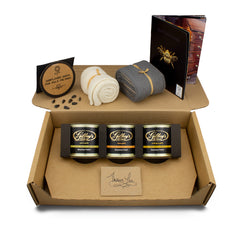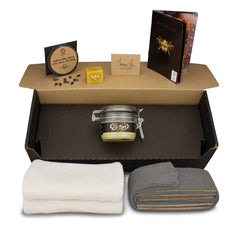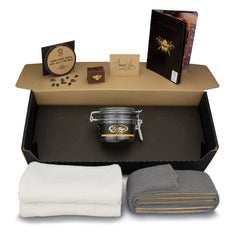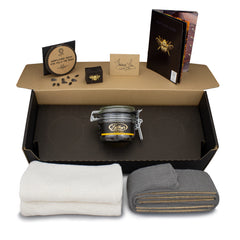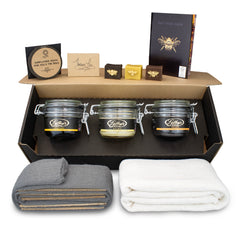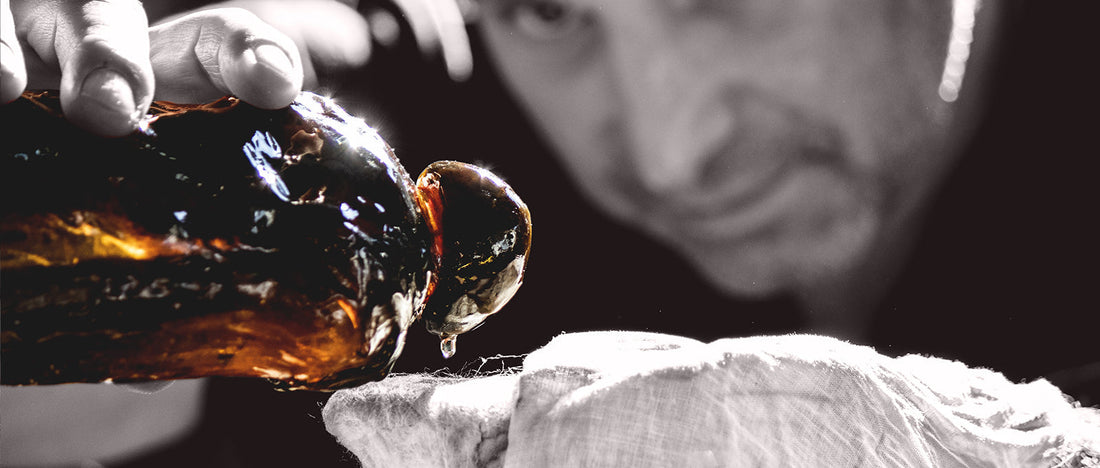
How to French Polish
Simon GilboyShare
WHAT IS FRENCH POLISH & HOW TO APPLY IT PROFESSIONALLY
We have been asked many times by our customers what is French Polish? Or what is French Polishing? In this article I demonstrate how we remove an old french polish finish on a John Broadwood piano fall and then french polish it to a high shine using entirely traditional methods.
The piano fall was taken from our shipping container of 'old wood' which is used to repair and restore our customers period furniture. It is made from solid mahogany with a rosewood decorative veneer applied to it.
The Six Processes of French Polishing
- Staining
- Grain Filling
- Fadding
- Colouring
- Bodying
- Spiriting
We are going to jump straight to stage three, as we don't want to stain the wood or fill the grain.
Preparation: Removing Old French Polish
Carry out ALL necessary repairs to the piece before stripping any old polish and any before any thoughts of refinishing.
I am using a professional chemical based furniture stripper which is harmful if in contact with the skin so protective gloves, clothing and eyewear should be worn. Apply the stripper carefully by using an old brush, avoid flipping the brush over and over to prevent splashing. The brush is used as a vehicle to move the stripper evenly over the surface.
Be generous and patient when applying the stripper, you may need several applications before you notice the old finish starting to lift.
Once the old surface has lifted you will need to remove it. This can be done with a decorators filler tool or a cabinet makers scrape or a hard plastic spatula.
Once the main body of old polish has been removed It is likely that you will need to apply more stripper. This will ensure that all of the old finish is completely removed and you have a clean surface to work with. Using rough wire wool (grade 4/5) will ensure all the old finish is taken away from the surface and with a bit of weight behind it scrub the surface until it is completely dry of stripper.
Use a cheap sponge scourer to neutralise the surface: When you are satisfied that all of the old finish is removed the next process is to neutralise the surface with water or methylated spirits (methylated spirit evaporates quicker and is unlikely to get into areas where the water soluble glue could be reversed). I used to use a splash of acetic acid (white vinegar) mixed in with the meths (10%) to help this process but we have found it isn't really necessary.
I would at this point leave the piece you have now cleanly stripped to dry overnight or a little longer.
Stage 1: Fadding - Initial Application
Shape a length of stockinet/buffing cloth into a fad and charge with french polish and a splash of methylated spirits. Apply the fad to the surface and and coat it with the polish. Now this is where it starts to get a little bit tricksy. The aim here is to lay down a few 'primer coats' of polish, don't get carried away and over apply, allow a few moments for the polish to dry before applying more polish with another pass of your fad.
Important Tip
Try not to think of french polishing the same way as a painter & decorator does - french polishing is not about applying layers of polish, this is something I see wrongly described and demonstrated all the time. The art french polishing is just that; an art, forget about layers and try to think of it as a creating a single body of polish a bit like a body of water in a lake.
Once you are satisfied you have enough polish on the surface leave it to dry for a few hours or overnight. You need to have enough french polish to seal the surface. It depends on how 'full or shiny' a french polished finish you want. A dull open-grain natural finish will require just enough polish to seal it. If you are looking for a fuller glossy finish you will need to apply few more fads of polish to help fill the grain.
Lightly sand the sealed surface with some 320 grit sandpaper and flatten the surface a little with some '0000' wire wool. The entire surface should be matt. You can often catch me continuously wiping my hands over the polished surface. The main reason for this is to pick up any small particles of dust. Using bare hands is the best way to do this, your hands are very sensitive and the slight moisture in the skin will pick these particles up better than any tack cloth, by all means use a tack cloth just finish off with your hands.
Stage 2: Colouring
In this example I'm carrying out any colouring on the piano lid. The circumstances where it is required is when there is maybe a little bit of sapwood showing or a light mark you want to colour away. Or you may want to adjust the overall tonal colour of the surface. This can be done with a small squirrel hair mop with an artist's pallet using raw powder pigments combined with a little polish and meths or in the form of a colour fad. A colour fad is made up the same as a polish fad but this time as well as using polish and meths we add spirit dye colours to it. This is a very skilled part of french polishing that requires lots of practice, a good eye for colour and dexterity with handling the fad.
Stage 3: Bodying - Creating the Polish Surface
When you are satisfied you have the all the above processes of French Polishing carried out to your satisfaction the next application to the surface is 'Bodying'. This is where we create the 'body' of french polish that I was mentioning earlier. Start off by making your 'Rubber', using cotton wadding which is shaped into a pear shaped fad. And again charged with french polish and a small splash of methylated spirits.
The fad is placed on to a square piece of pure cotton cloth (approximately 25cm x 25cm depending on the size of your fad) it is then carefully folded around the fad to form the shape of a rubber which you can see me demonstrating in our video How to make a french polishing rubber.
Creating Your French Polishing Rubber
- First make your rubber without it being charged - it should have a nice pear shape
- Open it up and charge the cotton fad inside
- Don't cheat by charging the rubber from the outside - it won't work as well
- Close the rubber up after charging
- Ensure the polish is evenly distributed with a flat face (the sole)
- Press the sole repeatedly on a flat surface until smooth with no creases
Apply the rubber to the surface in one continuous straight pass following the direction of the grain, do not stop or press hard on the surface. The rubber is fully charged so the polish will come out very easily at first.
As you reach the edge of your piece lift the rubber off the surface just a touch and then immediately come back down very gently in one smooth movement on to the bottom edge of where you have just applied. Repeat this action right across the surface a number of times, It will start to become more natural to you the more you do it, I promise!
Before going further with bodying, apply a few drops of white mineral oil to the surface (unboiled linseed oil works too, but not the 'boiled' type). The oil helps the rubber glide over the surface. You'll know when to use it when you hear a whooshing noise and the rubber starts to drag.
We now are starting to create a body of french polish. But if we carry on just applying it in straight lines we will end up with the finish looking streaky and brushed like varnish and we don't want that!
We need to start moving the polish about on the surface. This is where the term bodying comes from. We need to build up a mass of french polish on the surface and keep it all moving about so it fills out over the surface and forces the grain to be filled at the same time. This is also why we can only work on one area at a time. This is the crucial stage of french polishing that many 'french polishers' miss out or cheat. It's not easy, but the results when you get there are extremely rewarding.
The Bodying Motion
Start moving the rubber in the shape of a figure of eight, gradually increasing the arcs to form circles. Reduce the circle size and move across the surface. Then remove the whip marks by increasing the circles, returning to figure-eights, and finally making straight grain passes.
You may wish to repeat this process, recharging the rubber as you go along. It all depends on how much polish you want on the surface as this will ultimately be your finish.
Stage 4: Spiriting - The Final Process
This is the final process of french polishing. Hopefully you haven't used too much oil when you were bodying up. This is the final part of french polishing and the part I personally find most satisfying. Using the same rubber you have just been using open it up and charge it again but this time 50% french polish with 50% methylated spirit. *This is not an exact measurement. If your rubber still has some charge left in it I would be tempted to just add a splash of meths to it, it all depends on how dry your rubber is.
Bring the rubber up to your face and open your mouth, you will get an idea of how much meths is in the rubber. It sounds weird but it works. Again forcefully hit the sole/face of the rubber down on a flat disposable surface to make sure you have a nice contact area. Also make sure the face is clean of any old polish residue and doesn't have any creases in it.
Now the action is just the same as when you were bodying. Be very careful at first not to over apply and also not to dawdle on the surface. The rubber is now heavily charged with the solvent for french polish, if you hang around with it it will 'burn' (dissolve) the polish and you will have to work hard to pull the burn area out by bodying again. Work the spirit rubber quickly over the surface. The spirit will penetrate into the french polish and slowly it will burn off the oil trapped within it.
Testing for Oil Removal
Get your face close to the french polished surface, open your mouth and breathe on it. The moisture from your breath will fog the surface. If it shrinks back quickly and evaporates completely, your job is done. If it evaporates slowly or shows a rainbow edge, continue spiriting.
If you still have oil to remove, recharge your rubber with 25% french polish and 75% meths. Keep working the surface of polish, figure of eights, circles, figure of eights and straight grain actions. You will also find that the working face of the rubber has gone very white and your french polished finish is really starting to shine.
Eventually you may end up with a rubber that contains 100% methylated spirit. This is another reason why the polish becomes so glass like. This is due to the chemical action of the rubber burning the top layer of the polish which creates this mirror like finish, extremely pleasurable to watch and immensely satisfying to do.
Dulling - The Seventh Stage of Polishing (Optional)
The reason this seventh stage was not impressed upon me as an apprentice is because it isn't a necessary process of french polishing. There is no reason for this stage apart from personal preference. Dulling is a general term for the many different ways a french polish is dulled down or matted.
Important
Allow your newly polished work to dry for 24 hours before attempting any further work on it.
Method 1: Using Fine Wire Wool
Tease out a folded flat pad of '0000' wire wool in the palm of your hand. Apply it to the surface and with continuous even pressure in the direction of the grain, wipe it over the surface. Be sure to do this in the direction of the grain, being extremely conscious of not arcing your arm or wrist. If you arc your arm at any point, the resulting finish will look fake and unnatural.
Method 2: Wire Wool with Oil
Create the exact same pad of wire as above but this time add some mineral oil to the surface and to the wire wool, be generous. On horizontal surfaces you could pour it on. Now this time you can be a little more free with your direction and you may even want to move on wide circular motions with the pad.
The effect we are trying to achieve here is a 'used but cared for' surface. It's not quite as abrasive as just using the wire wool on its own. The mineral oil softens the effect and allows the wire wool to move in many directions without any severe scratches.
The Final Touch: Beeswax Polish
Once you have dulled with the wire wool using either of the above techniques, the best way to complete your project is to apply a good beeswax polish over the top. Again, using the soft wire wool to apply the polish. Leave it on for 30 minutes or longer, then buff to a beautiful deep shine.
Why use beeswax polish and what does it do? In brief: Beeswax polish further enhances the natural beauty of the wood, and acts as a sacrificial layer that protects and preserves the finish it is applied to.
It is an area of wood finishing that we believe has been very much overlooked for many years. It is the reason our french polishers here at Gilboy's have spent years developing the best beeswax polish we possibly could, using the very best of ingredients available in the world.
-----

 Video: How To French Polish
Video: How To French Polish